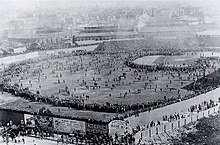Deadball era
The deadball era (eng .: dead-ball era or deadball era ) describes a period of the American baseball league Major League Baseball , which extended from 1901 to 1919 and through a historical low point of offensive performances, but also through increasing professionalization is marked.
history

In the early days of professional baseball, the conditions for batsmen were adverse. Back then, the same ball was used for the entire game, which was so deformed and dirty by the middle of the game at the latest that it was completely unpredictable and difficult to see. The pitchers were allowed to manipulate the baseball as they saw fit, which is why they colored the game device darker with tobacco juice, spat on it for a better grip ( spitball ), scraped it or threw it against a wall (which increased the imbalance during the flight) or the like. Other factors were these Stadiums themselves. Because they were bigger at the time, you had to hit the ball an average of 10 to 20 meters for a home run (except Inside the Park ). Stadiums like the Huntington Avenue Grounds (Boston Red Sox) were often built to one side, making such home runs over the wider side impossible. In addition, there was no floodlight back then, which is why the batsmen had to struggle with poor visibility at dusk.
As a result, the offensive game was extremely limited. Since the batsmen found it pointless to try home runs, they limited themselves to short hits, steals and bunts . Since in this way one per point i. d. Usually four hits, games with soccer results (e.g. 1−0, 2−1, 3−2) were common. This phlegmatic game was called "Dead Ball" by historians.
The scandalous World Series 1919 is considered the end point of the Deadball era . According to today's opinion, the bribery scandal surrounding the Chicago White Sox ended the innocent early days of the MLB. In addition, the rules were gradually changed, so that ball manipulation (especially spitballing) was prohibited, more balls were used per game and floodlights were introduced. These changes heralded the so-called live ball era with power hitters like Babe Ruth and Lou Gehrig .
Records

During the deadball era (see fig.) Both slugging percentage and runs sank to an all-time low. Batsman Frank Baker was christened "Home Run Baker" because he ended several seasons with a double-digit number of home runs - which is completely unnoticed today. The Chicago White Sox hit three home runs once throughout the season but still won 88 games and lost just 64.
Some positive records have also been set. Ty Cobb hit a career batting average of .366 and had a season with .420. Ed Walsh had a career earned run average of 1.82. All of these numbers are considered records for the ages.
Stars of the deadball era
The best batsmen of the deadball era are Ty Cobb, Honus Wagner and Shoeless Joe Jackson , the best pitchers Cy Young , Christy Mathewson and Walter Johnson .
Books
- Baseball's Offensive Greats of the Deadball Era: Best Producers Rated by Position, 1901-1919 , Robert E. Kelly, McFarland, 2009, ISBN 978-0-7864-4125-9 .
- Ballparks of the Deadball Era: A Comprehensive Study of Their Dimensions, Configurations and Effects on Batting, 1901-1919 , Ronald M. Selter, McFarland, 2008, ISBN 978-0-7864-3561-6
